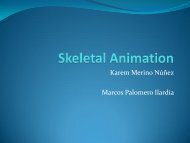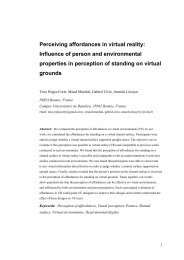Implicit Contact Handling for Deformable Objects
Implicit Contact Handling for Deformable Objects
Implicit Contact Handling for Deformable Objects
- No tags were found...
You also want an ePaper? Increase the reach of your titles
YUMPU automatically turns print PDFs into web optimized ePapers that Google loves.
M. A. Otaduy, R. Tamstorf, D. Steinemann & M. Gross / <strong>Implicit</strong> <strong>Contact</strong> <strong>Handling</strong> <strong>for</strong> De<strong>for</strong>mable <strong>Objects</strong>Accounting <strong>for</strong> the numerical integration method (implicitEuler in our case), we can trans<strong>for</strong>m the implicit positionconstraints into velocity constraints. To do this, we first expressthe position update of contact points in terms of theirvelocities, p = p 0 +∆tṗ. The velocities of contact points canin turn be expressed in terms of the state velocity vector, asṗ = ∂ṗ∂ṗv. In our examples, the rows of the Jacobian ∂v ∂v constitutetriangle barycentric weights (<strong>for</strong> cloth) or tetrahedronbarycentric weights (<strong>for</strong> volumetric FEM). To summarize,the semi-implicit position constraints from Eq. (4) are trans<strong>for</strong>medinto velocity constraints of the <strong>for</strong>m:Jv ≥ − 1 ∆t g 0, (5)with J = ∂g ∂ṗthe generalized constraint normal.∂p ∂v3.3. Mixed Linear Complementarity ProblemWe model collision response with the method of Lagrangemultipliers, and express contact <strong>for</strong>ces as J T λ. Additionally,we employ Signorini’s contact model [DDKA06], which imposesnon-sticking constraints λ ≥ 0 on the contact <strong>for</strong>ces,and the complementarity condition 0 ≤ λ ⊥ g(p) ≥ 0. Complementarityhere means that contact points cannot push(λ > 0) and be distant (g(p) > 0) at the same time.The resulting system of equations is a mixed linear complementarityproblem (MLCP, called ‘mixed’ as it combineslinear equalities and inequalities). Given unconstrained velocitiesv ∗ , the MLCP that defines the constrained velocitiesv can be expressed as:A∆v = J T λ, ∆v = v − v ∗ ,0 ≤ λ ⊥ J∆v ≥ − 1 ∆t g 0 − Jv ∗ . (6)The MLCP is equivalent to a quadratic program [CPS92]where the objective function to be minimized is 1 2 ∆vT A∆v,subject to the contact constraints from Eq. (5). The inclusionof A in the distance metric of the objective function ensuresthat our algorithm is aware of the discretization method andthe internal dynamics of the de<strong>for</strong>ming objects.3.4. FrictionWe model friction with a pyramid approximation ofCoulomb’s friction cone, which allows us to naturally incorporateit into the constrained optimization <strong>for</strong>mulationdescribed above. We have opted <strong>for</strong> a 4-sided pyramid, butmore complex approximations are possible if higher accuracyis needed. Given a contact with constraint n T (p a −p b ) ≥ 0, we first compute the tangent unconstrained relativevelocity v ∗ t = (I − nn T )(v ∗ a − v ∗ b ). We then align the4-sided friction pyramid with this velocity, which amountsto computing unit tangent vectors t 1 = v ∗ t /‖v ∗ t ‖ and t 2 =n × t 1 . And we add friction <strong>for</strong>ces to the dynamics equationin Eq. (6) using Lagrange multipliers, which yields <strong>for</strong>cesγ 1 t 1 and γ 2 t 2 <strong>for</strong> each contact. In vector <strong>for</strong>m, these friction<strong>for</strong>ces can be expressed as H T γ. The 4-sided pyramidaligned with the unconstrained velocity has served as a goodapproximation in our examples.We handle friction in the constrained dynamics problemby augmenting the MLCP from Eq. (6) in the followingway. Given a friction coefficient µ, we express the followingcomplementary constraints <strong>for</strong> each contact: a linearizedCoulomb cone constraint ‖γ 1 ‖ ≤ µλ, and a velocity constraintv t1 ≥ 0 that prevents friction from reversing motion(and similarly <strong>for</strong> γ 2 ). Altogether, the problem from Eq. (6)turns into the following nonlinear complementarity problem:A∆v = J T λ + H T γ,0 ≤ λ ⊥ J∆v ≥ − 1 ∆t g 0 − Jv ∗ ,‖γ‖ ≤ µλ ⊥ H∆v ≥ −Hv ∗ . (7)In Section 5.4 we will describe our solution to frictional constraineddynamics, which is based on a decoupling of thenon-penetration and frictional problems.4. Constraint Manifold RefinementThe solution to our constrained dynamics problem alonedoes not guarantee a penetration-free state at the end of atime step. There are two possible reasons: the linearizationof the contact constraints, and the fact that the collision responseinduced by some constraints g may in turn violateother constraints that were not accounted <strong>for</strong>. In this section,we describe the first of our major technical contributions, atime-stepping algorithm based on constraint manifold refinementthat will guarantee a collision-free state. We also givean overview of how other different novel aspects of our workfit into the overall algorithm.We assume that a time step starts with a collision-freestate, (q 0 ,v 0 ). Then, the dynamics described by the linearizeddiscrete system A from Eq. (2) would yield an unconstrainedstate (q ∗ ,v ∗ ). However, we aim <strong>for</strong> a state (q,v)that satifies the constraint manifold Γ, and minimizes the‘distance’ to the unconstrained state subject to the metric A.The constraint manifold Γ that determines valid dynamicssolutions is nonlinear and highly dimensional. As an alternative,we propose the creation of a local conservative boundof Γ, through a process of progressive constraint manifoldrefinement (CMR). CMR intertwines steps of collision responsecomputation and continuous collision detection <strong>for</strong>reaching a collision-free state at the end of the time step. Anexample application of the CMR algorithm is schematicallydepicted in Fig. 3. Along with the initial and unconstrainedstates, CMR maintains a set of linear constraints g (describedin Section 3.2) that locally approximate Γ.At each iteration of CMR, we per<strong>for</strong>m a frictional constraineddynamics update as described in Section 3.4. Thisresults in a tentative simulation state (q,v) that satisfies thec○ 2008 The Author(s)Journal compilation c○ 2008 The Eurographics Association and Blackwell Publishing Ltd.





